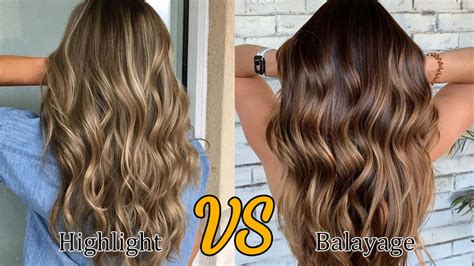With countless hair coloring techniques available, understanding the nuances between them can be daunting. Two popular options, highlights and balayage, offer distinct results that cater to different style preferences. This article explores the fundamental differences between highlights and balayage, providing you with the information you need to make an informed decision that complements your desired look.

1. Technique:
-
Highlights:
- Involves isolating small strands of hair and applying bleach or color directly to them.
- Creates a more traditional, obvious contrast between the highlighted sections and the rest of the hair.
- Typically uses a foil or cap to separate the highlighted strands.
-
Balayage:
- A hand-painted technique that involves applying bleach or color freehand to the hair.
- Creates a more natural, blended look with softer transitions between colors.
- Does not use foils or caps, resulting in a more seamless effect.
2. Placement:
-
Highlights:
- Can be placed anywhere on the head, including the crown, sides, and bangs.
- Often applied in a geometric or symmetrical pattern.
- Can create a more structured or dramatic look.
-
Balayage:
- Typically applied to the mid-lengths and ends of the hair.
- Focuses on creating a sun-kissed, natural look.
- Can be customized to frame the face or enhance certain facial features.
3. Contrast:
-
Highlights:
- Typically creates a higher level of contrast, with highlighted strands standing out against the rest of the hair.
- Can be used to create bold, noticeable accents.
-
Balayage:
- Produces a more subtle, blended contrast that mimics natural hair growth.
- Creates a seamless transition from the roots to the ends.
4. Maintenance:
-
Highlights:
- Requires regular touch-ups (every 6-8 weeks) to maintain the contrast and prevent root growth from becoming visible.
- Can be more damaging to the hair due to the use of bleach.
-
Balayage:
- Requires less frequent touch-ups (every 3-4 months) as the root growth is less noticeable.
- Can be less damaging to the hair as it uses less bleach and involves a more gentle technique.
5. Cost:
-
Highlights:
- Generally more expensive than balayage due to the more time-consuming application process and use of foils or caps.
-
Balayage:
- Can be more affordable than highlights, especially when done on shorter hair or with minimal coverage.
6. Versatility:
-
Highlights:
- Can be customized to create various looks, from subtle accents to bold streaks.
- Suitable for all hair colors and textures.
-
Balayage:
- Offers a more limited range of looks compared to highlights.
- Best suited for darker hair colors or those seeking a natural, sun-kissed effect.
7. Longevity:
-
Highlights:
- Lasts for up to 10 weeks, depending on the frequency of washing and maintenance.
- May fade or become brassy over time.
-
Balayage:
- Can last for up to 3-4 months, as the root growth is less noticeable.
- Tends to retain its color and vibrancy for longer periods.
8. Suitability for Different Hair Types:
-
Highlights:
- Suitable for all hair types, but can be more damaging to fine or fragile hair.
-
Balayage:
- Best suited for medium to thick hair.
- Can be more forgiving on damaged or over-processed hair.
9. Time Required:
-
Highlights:
- Takes 2-4 hours or more, depending on the number and thickness of the highlights.
-
Balayage:
- Can take anywhere from 2-6 hours or more, depending on the desired coverage and complexity of the technique.
10. Overall Effect:
-
Highlights:
- Creates a more dramatic and noticeable change in hair color.
- Can add volume and dimension to the hair.
-
Balayage:
- Provides a more natural-looking, sun-kissed effect.
- Can enhance the hair’s texture and movement.
11. Benefits of Highlights:
- Adds dimension and brightness to the hair.
- Can create the illusion of volume.
- Suitable for all hair colors and textures.
- Can be customized to create various looks.
12. Benefits of Balayage:
- Provides a more natural, sun-kissed effect.
- Less damaging to the hair than highlights.
- Requires less frequent touch-ups.
- Enhances the hair’s texture and movement.
13. Creative New Word:
- “Sombre”: A hybrid technique that combines the subtle blending of balayage with the bolder contrast of highlights.
14. FAQs:
1. Which technique is more suitable for me?
The best technique depends on your personal style, hair type, and desired results. Consult with a professional hairstylist to determine the most flattering option for you.
2. Can I do highlights or balayage at home?
While it is possible to attempt these techniques at home, it is highly recommended to seek the expertise of a trained hairstylist to ensure optimal results and prevent damage.
3. How often should I touch up my highlights or balayage?
The frequency of touch-ups varies depending on the technique used, hair growth rate, and desired level of maintenance. Highlights typically require touch-ups every 6-8 weeks, while balayage can last for up to 3-4 months.
4. Can highlights or balayage damage my hair?
All hair coloring techniques involve some level of chemical processing, which can potentially damage the hair. Highlights generally involve more bleaching, which can be more damaging to the hair than balayage. However, proper care and maintenance can minimize the risk of damage.
5. Can I combine highlights and balayage in one treatment?
Yes, it is possible to combine highlights and balayage in the same treatment to create a unique and customized look. This technique is often referred to as a “hybrid” or “sombre.”
6. Which technique is more versatile?
Highlights offer greater versatility, allowing for a wider range of looks, from subtle accents to bold streaks. Balayage is best suited for creating natural, sun-kissed effects.
7. Which technique is more cost-effective?
Balayage can be more
